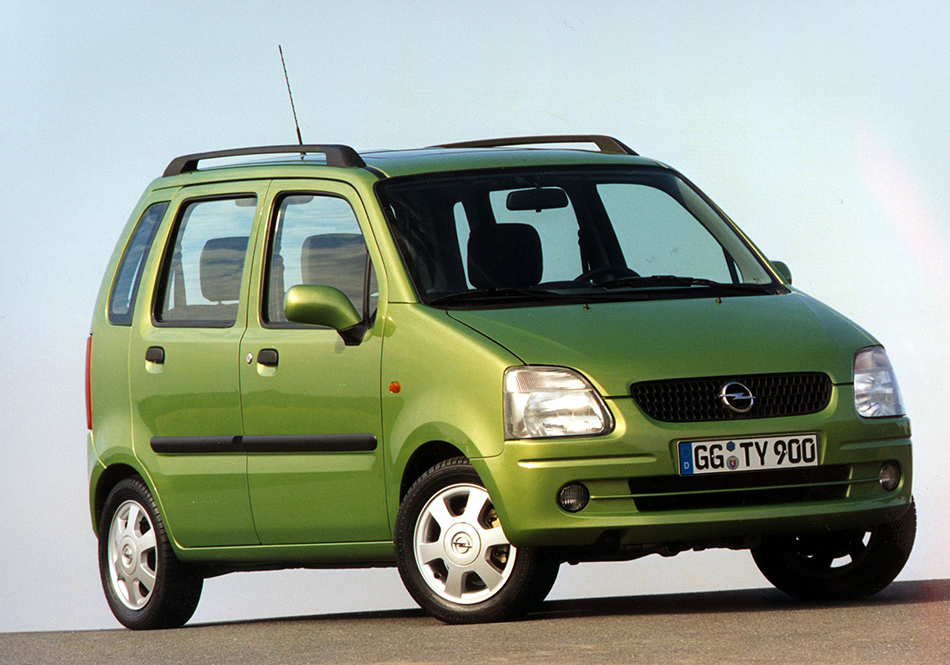The all-new Agila, which will extend Opel's model range into the growing microvan market, makes its world debut at the 70th Geneva Motor Show from March 2-12, 2000. Despite its overall length of only 3.50 meters, the Agila features a spacious and versatile interior. It converts quickly from a comfortable four-seater to a two-seater with a flat floor and 598 liters of luggage space. Youthful styling and excellent accessibility provided by four doors and a large rear hatch are complemented by high quality and a 12-year anti-perforation warranty. The front-wheel drive Agila is powered by a choice of two lively 1.0 and 1.2 ECOTEC gasoline engines with 43 kW/58 hp and 55 kW/75 hp respectively. Both these economical, four-valve power units already comply with the strict Euro IV exhaust emission standard which does not come into force until 2005. When it goes on sale in May 2000, the first microvan (or Mini People-Carrier) from a European manufacturer will offer a value-for-money alternative to conventional mini cars, especially in urban areas.

The Agila's styling – especially the typical hood and grille design – make it immediately recognizable as a member of the Opel family. Large headlamps underline its friendly, approachable personality. Its compact exterior (length 3.50 m / width 1.62 m / height 1.66 m) belies its spacious interior with full-scale seating for four adults, copious headroom and a load area that holds 248 liters (VDA standard), enlarging to 598 liters (measured to lower edge of windows) as required. The rear seat cushion and the 50:50 split rear seat back can be folded together quickly and easily, in a single operation, by means of a clever mechanism to provide a flat load bay. Thanks to the tall, wide tailgate and the low sill (655 mm), large objects can be loaded with ease. Developed jointly by Opel and its Japanese partner, Suzuki, the new microvan features numerous opportunities for storing a variety of objects. There are integrated compartments in the instrument panel, drawers under both front seats, cup holders and pockets in the front and rear doors as well as in the front seat backs.
Inside the functional passenger compartment, three fabrics are available to complement one of ten body paint finishes. The high seating position and the large glass area (including a third, C-pillar window) enhance the light, friendly, atmosphere of the interior, giving the driver and passengers an excellent view of the car's extremities and the surrounding traffic. Rear-seat passengers will appreciate the particularly good all-round vision afforded by sitting ten centimeters higher than the driver and front passenger.
In addition to the entry-level, Agila buyers can choose from two higher specification levels. The entry-level model is equipped with electric power steering, the split rear seat, a triple info-display, electrically adjustable exterior mirrors, a carpet-lined trunk, and a radio installation kit including a roof-mounted antenna and loudspeakers. Every Agila also comes with a comprehensive safety package including a stable passenger compartment with side impact protection beams in the doors, driver airbag, as well as seatbelt tensioners and belt-force limiters for the front seats. In case of a severe frontal impact, the pedals release, thus significantly reducing the risk of injury to the driver's feet and lower legs (Pedal Release System). The rear seats are equipped with Opel Fix anchor points to install the corresponding child seats. There are child safety locks on the rear doors. The wide range of optional extras includes a passenger airbag and a safety net between the load area and the rear seats.
Opel's engineers fine-tuned the Agila's dynamic chassis to provide high standards of safety, comfort and handling. With a wheelbase of 2.36 m and correspondingly short overhangs, the Agila has a turning circle of only 9.95 meters and offers excellent maneuverability, especially in an urban environment. Electric Power-Assisted Steering (EPS) makes parking even easier and also reduces fuel consumption. The Agila is the only microvan to have 14-inch wheels (with 155/65 R 14 tires), which contribute further to its stability. The latest Bosch anti-lock braking system is installed and the brakes achieve excellent rates of deceleration for a vehicle in this class.
The Agila's two lively, economical ECOTEC engines are coupled to a five-speed manual gearbox and feature modern technologies such as "drive by wire" (electronic throttle control) and a micro-hybrid electronic engine control unit, which is more compact and more durable than conventional types. Both four-valve-per-cylinder units are fun to drive and deliver high standards of environmental compatibility, complying with the most stringent Euro IV exhaust emission limits which do not come into force until 2005. The perky, 1.2-liter, four-cylinder engine takes the Agila from a standing start to 100 km/h in only 13.5 seconds and on to a top speed of 155 km/h. Maximum torque is 110 Nm at 4000 rpm and fuel con-sumption is only 6.5 liters per 100 km (MVEG standard). Powered by the 1-0-liter, three-cylinder engine, the Agila has top speed of 142 km/h and consumes only 6.3 liters of fuel per 100 kilometers (MVEG standard). Maximum torque of 85 Nm is available at 3800 rpm.
Both engines are further developed versions of the well-proven units used in Opel's best-selling Corsa. They require minimum service. The valve gear and camshafts, for instance, are maintenance-free, and all the items in the engine compartment that need to be checked are easily accessible. In addition, Opel's new microvan is designed to be easy to repair, thus further reducing the cost of ownership.
The Agila is built at Opel's newest plant in Gliwice, Poland. This modern facility, which was opened in fall 1998, is modeled on Opel's highly efficient Eisenach factory (in eastern Germany) and employs state-of-the-art production processes to ensure similarly high standards of quality, which are reflected in the 12-year anti-perforation warranty. During the first full year of production, Opel plans to build 100,000 of its spacious new microvans.
Source: Opel











